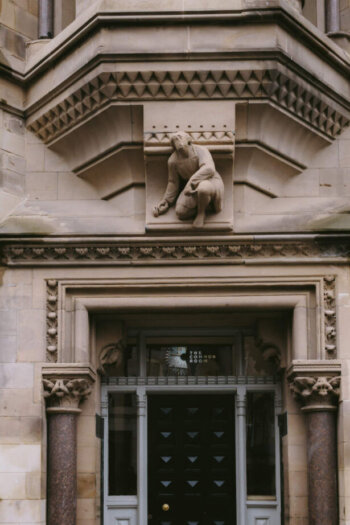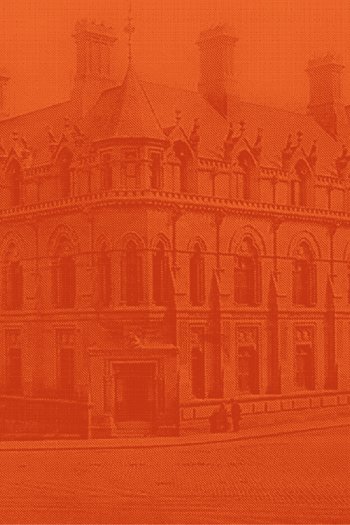Commuters stream in and out of the nearby station, taxis rush by, and the sounds of cars and buses are ever-present. Despite being surrounded by people, the building remains largely invisible to the general public. For too long, Neville Hall has been in the shadows of the city, its rich and fascinating history forgotten. Once a vibrant hub for scientific debate and the mining industry that connected the entire North East, its importance cannot be overstated for both the local community and the wider country.
Now, the local charity The Common Room, based within its historic halls, is focused on highlighting the building’s past significance and inspiring the next generation to achieve their dreams.
Most notably, Neville Hall has been, and still is, the home of the North of England Institute of Mining and Mechanical Engineers (NEIMME). The institution was established in 1852 in Newcastle by a ‘small coterie of friends’ who initially met at a public house in Seaham. This group consisted of engineers and individuals in positions of power within the collieries.
At that time, coal mining was the primary industry in the North East, providing jobs for thousands, with many mines located in the area. However, despite the substantial profits it generated, mining was extremely dangerous, with accidents and deaths being not only common but inevitable, especially given the working conditions. The number of accidents was increasing rapidly, from 734 before 1815 to 968 up to 1845, and reaching 250 a year after 1850. This was mainly due to mine owners sending workers deeper into the mines, where explosive gases were likely to be found, leading to numerous large-scale tragedies throughout the North East.
This alarming situation prompted the group of engineers to establish NEIMME with two primary aims: to devise measures to prevent or mitigate such dreadful calamities, and to establish a literary institution devoted to the theory, art, and practice of mining.
Initially, the Institute held its meetings at the Literary and Philosophical Society in Newcastle, which still stands today next to Neville Hall. The first meeting of NEIMME took place there on 21 August 1852, and meetings continued at this location for many years.
By the mid-1860s, the Institute’s Council became concerned about the Lit & Phil’s focus on literary artefacts and collections. Encouraged by Sir Isaac Lowthian Bell, the NEIMME decided it needed its own headquarters. In 1868, the funds collected for the Institute’s building were used to purchase land adjacent to the Lit & Phil, formerly the site of the old Medical School. Archibald Dunn, known for his Gothic style, was selected as the lead architect.
In 1872, the site designed by Dunn was opened as the building now known as Neville Hall. Upon its opening, NEIMME shared the space with the Coal Trade’s Association, and a bridge was built to connect the Lit & Phil with the Nicholas Wood Memorial Hall. This remarkable building has stood for over 150 years, and has been fully renovated and restored in the late 2010s and early 2020s through the efforts of The Common Room. Much of the original architecture has been preserved, bringing Neville Hall back to its former glory.
Inside Neville Hall, there are many beautiful rooms of historical significance. The famed Nicholas Wood Memorial Hall, with its Gothic style and stunning stained glass windows, is named after the Institute’s first President. Wood, a mining engineer, revolutionised the industry during the transition to deep shaft mining in East Durham. He was re-elected every year until his death in 1865, and his statue currently resides in the hall. The room stands as a tribute to Wood’s significant impact on NEIMME, despite his passing before the completion of Neville Hall.
Another historic room, the Stephenson Room, is named after George and Robert Stephenson. George Stephenson was a renowned railway engineer who pioneered transport links between cities, including building the Liverpool and Manchester Railway, the first to use locomotives between cities. Together with his son Robert, they built the first steam locomotive to carry passengers on the Stockton and Darlington Railway in 1825. Robert, also a member of the Lit & Phil and an apprentice to Nicholas Wood, contributed significantly to the fields of mechanical and civil engineering. He became a member of NEIMME in 1852 and vice-president in 1854, leaving a lasting legacy.
The historic Lecture Theatre, completed in 1902, features portraits and photographs of all the past presidents of NEIMME.
Today, these rooms continue to host various events, adding to their rich history and ensuring they remain remembered. The Common Room, which now occupies Neville Hall alongside NEIMME, has worked tirelessly to restore the building and showcase its multifaceted history to the public. The extensive archive collection has been invaluable to many studies, and General Admission days have introduced this history to hundreds.
Furthermore, The Common Room actively leverages Neville Hall’s history to encourage young people to engage with STEM subjects, much like the building’s original inhabitants. Various programmes are held within the Hall, inspiring young people in the North East to explore STEM careers and connect with the region’s heritage while looking towards their futures. The Common Room and Neville Hall truly represent a harmonious blend of past and future.
-Ruby
Work experience student, The Common Room

